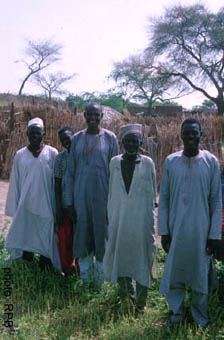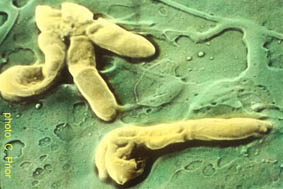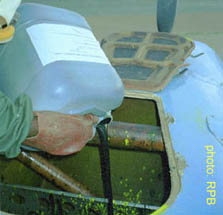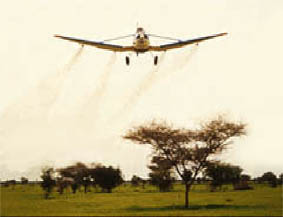|
Locust Control and the Making of ‘Green Muscle’ |
|||||||||||||
The potential for using Metarhizium as a pest control agent was first observed over a century ago by the Russian scientist Ilya Ilich Metschnikoff. Since then much has been written about the use of this fungus, together with other species such as Beauveria bassiana, as insect control agents (mycoinsecticides), but unfortunately chemicals remain prevalent. One of the key constraints was that Metarhizium and Beauveria, like other fungi, usually require high humidity in order to infect their hosts. A critical discovery changed this. Dr Chris Prior observed that spores of these fungi could be more infectious when formulated in oil[2], with their action more independent of environmental conditions.
This discovery led to the development of an oil-based fungal product that could be applied in a very similar way to standard locust control chemicals, which are also formulated in oil. I called this product 'Green Muscle'™ (a play on the English name for Metarhizium: the 'green muscardine fungus') and it seems to have caught on. The genus Metarhizium can be used to kill a wide range of insects, but 'Green Muscle' is based on a specific isolate which targets locusts and grasshoppers, and has been proved to work effectively. However 'Green Muscle is specific, and only works against species within this group[3] Specificity is an important feature of biological pesticides, because they have little or no adverse environmental impact, benefiting not only humans but also other animals: including the natural enemies of the pests themselves. However, from a commercial point of view, this severely limits markets and biopesticides are most likely to be produced by the small-medium sized enterprises. Therefore ready-made solutions are required for any problems in technical development.
During the course of the Programme, it became clear that two of the key technical challenges in the development of mycoinsecticide product were mass production and delivery systems (including formulation and application). These procedures are linked by a critical process: the separation of fungus spores from their substrate, and a purpose-built device developed which eventually "evolved" into a device called the ‘MycoHarvester’. This is an example of an "enabling technology", which can assist in the exploitation of a range of micro-organisms environmentally safe pest control for both Western and developing countries. Green Muscle has now been adopted by commercial partners and successful operations continue to be reported - including a recent example - control of the red locust in East Africa. However, reaching this stage was expensive: the LUBILOSA Programme eventually cost donors approximately €15 million (although this is an order of magnitude cheaper than developing a chemical pesticide). Perhaps equally important are the "spin offs" that enable research groups around the World to bring about biological control solutions for other pests more rapidly, using similar technologies. ©
Roy Bateman,
March 2015 |
|||||||||||||
|
[1] LUtte BIologique contre les LOcustes et les SAuteriaux: a collaborative, multi-disciplinary research and development programme funded by the Governments of Canada (CIDA), the Netherlands (DGIS), Switzerland (SDC) and the UK (DfID). [2] Prior, C., Jollands, P. and Le Patourel, G. (1988) Infectivity of oil and water formulations of Beauveria bassiana (Deuteromycotina; Hyphomycetes) to the cocoa weevil pest Pantorhytes plutus (Coleoptera: Curculionidae). Journal of Invertebrate Pathology, 52, 66-72. [3] Lomer C.J., Bateman R.P., Johnson D.L., Langwald, J. and Thomas, M. (2001) Biological Control of Locusts and Grasshoppers. Annual Review of Entomology 46:667 -702. |
|||||||||||||

 dropdata.org
Home page
dropdata.org
Home page



